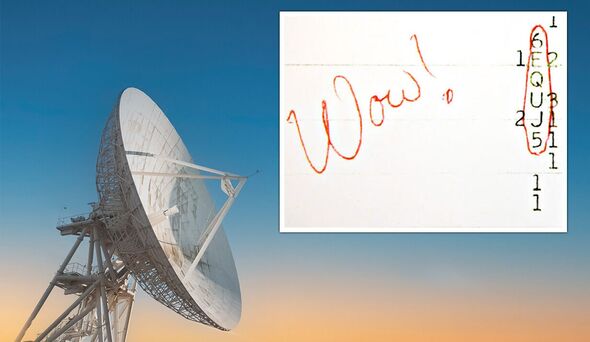Science
Scientists Offer New Explanation for 1977 Wow! Signal Mystery

A groundbreaking study has potentially resolved the mystery surrounding the enigmatic Wow! signal, a radio burst detected nearly five decades ago. First recorded on August 15, 1977, by the Big Ear radio telescope at Ohio State University, the signal has long been regarded as a possible indicator of extraterrestrial life. Now, research from the Arecibo Wow! Project suggests a natural origin for this iconic signal.
The Wow! signal was a 72-second burst occurring at a frequency of 1420 MHz, the same frequency as hydrogen, the most abundant element in the universe. Astronomer Jerry Ehman famously inscribed “Wow!” on the printout after observing the unusual signal. For decades, its origin has sparked numerous theories, ranging from comets to space debris to intelligent extraterrestrial communications.
In a study published on August 14, 2025, on the preprint server arXiv, the Arecibo Wow! Project team, led by planetary astrobiologist Professor Abel Mendez of the University of Puerto Rico, re-examined 75,000 pages of archival data. This extensive analysis included digitising and refining previous measurements, leading to the conclusion that the Wow! signal was significantly stronger than earlier estimates, exceeding 250 Janskys, and more precisely localised within the constellation Sagittarius.
The researchers propose that the signal was likely caused by a flare from a magnetar, a highly magnetised neutron star, interacting with a cold interstellar hydrogen cloud. This interaction could have triggered a “maser flare,” a natural amplification of hydrogen emissions akin to a cosmic laser. This new explanation accounts for the signal’s intensity, narrow bandwidth, and its one-time occurrence.
The study also effectively dismisses the likelihood of terrestrial interference from satellites, television signals, or solar activity. Earlier hypotheses suggesting that comets or reflections from space debris were responsible have also been ruled out. Observations from the Arecibo telescope, prior to its collapse in 2020, had detected weaker emissions from hydrogen clouds that align with this new theory.
Despite this compelling evidence, some scientists remain cautious. The hydrogen frequency is traditionally viewed as a prime candidate for potential extraterrestrial beacons. Previous researchers, including former Big Ear director John Kraus, described the Wow! signal as “highly suggestive” of intelligent origin. While the possibility of alien involvement cannot be entirely discounted, the current findings provide a more grounded explanation.
Adding another layer to the discussion, the recent discovery of interstellar comet 3I/ATLAS (C/2025 N1), currently traversing the solar system from the same region of Sagittarius, has sparked speculation about a potential link to the Wow! signal. Nevertheless, most astronomers argue that the comet’s observed outgassing and dust tails are characteristic of typical comet behaviour.
The Wow! signal remains a significant highlight in the search for extraterrestrial intelligence (SETI). Other notable candidates include the short-lived radio burst known as “SHGb02+14a,” identified during a SETI survey in 2003, and unexplained narrowband signals from Proxima Centauri examined in 2020 under the “Breakthrough Listen” initiative. Each of these signals was later determined to likely have natural or terrestrial origins, underscoring the ongoing challenge of distinguishing potential alien communications from cosmic noise.
Professor Mendez emphasized that this new analysis does not close the case on the Wow! signal, but rather “reopens it, with a much sharper map.” The team aims to complete the digitisation of all Big Ear data by 2027, coinciding with the 50th anniversary of the signal’s detection. Future advancements, such as the Square Kilometre Array, are anticipated to enhance sensitivity and may ultimately clarify whether the Wow! signal was indeed a rare natural phenomenon or something more extraordinary.
-

 Health2 months ago
Health2 months agoNeurologist Warns Excessive Use of Supplements Can Harm Brain
-

 Health2 months ago
Health2 months agoFiona Phillips’ Husband Shares Heartfelt Update on Her Alzheimer’s Journey
-

 Science7 days ago
Science7 days agoBrian Cox Addresses Claims of Alien Probe in 3I/ATLAS Discovery
-

 Science5 days ago
Science5 days agoNASA Investigates Unusual Comet 3I/ATLAS; New Findings Emerge
-

 Science2 days ago
Science2 days agoScientists Examine 3I/ATLAS: Alien Artifact or Cosmic Oddity?
-

 World2 months ago
World2 months agoCole Palmer’s Cryptic Message to Kobbie Mainoo Following Loan Talks
-

 Entertainment3 months ago
Entertainment3 months agoKerry Katona Discusses Future Baby Plans and Brian McFadden’s Wedding
-

 Entertainment3 months ago
Entertainment3 months agoEmmerdale Faces Tension as Dylan and April’s Lives Hang in the Balance
-

 Entertainment3 months ago
Entertainment3 months agoLove Island Star Toni Laite’s Mother Expresses Disappointment Over Coupling Decision
-

 Entertainment2 months ago
Entertainment2 months agoMajor Cast Changes at Coronation Street: Exits and Returns in 2025
-

 World2 months ago
World2 months agoCoronation Street’s Asha Alahan Faces Heartbreaking Assault
-

 Entertainment2 weeks ago
Entertainment2 weeks agoStefan Dennis and Dianne Buswell Share Health Update on Strictly Come Dancing









